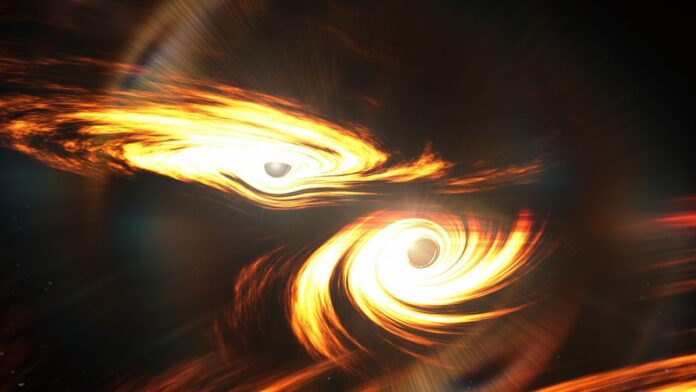Black holes are some of the most enigmatic objects in the universe. This is partially because the equations of general relativity that we use to understand them break down when studying black holes’ ultra-dense centers.
However, a new paper shows how astronomers could one day overcome this challenge by using gravitational waves to “see” inside merging black holes, and learn what they’re really made of.
Gravitational microscopes
In Einstein’s general theory of relativity, black holes are objects that prevent light from escaping due to their enormously strong gravity. The boundary of a black hole is known as the event horizon — if you pass beyond that threshold, you won’t ever make it out. Relativity also predicts that the centers of black holes are points of infinitely high densities, known as singularities.
The presence of singularities means that the equations themselves are breaking down; infinities start appearing in the math which prevent further calculations. So we know that general relativity is incomplete. There must be a more fundamental theory, probably linked to the quantum physics of subatomic scales, that can properly describe what’s happening in the center of a black hole.
We do not yet have any complete quantum theory of gravity, but we do have several candidates. For example, there’s string theory (opens in new tab), which predicts that all particles in the universe are actually made of ultra-tiny vibrating strings. There’s also loop quantum gravity, which says that space-time itself is made of tiny, indivisible chunks like pixels on a computer screen.
Both of these approaches can replace the traditional singularity in the center of a black hole with something else. But when you replace the singularity, you usually also eliminate the event horizon. That’s because the event horizon is caused by the infinite gravitational pull of the singularity. Without the singularity, the gravitational pull is merely incredibly strong, but not infinite, and so you’re always able to escape the vicinity of a black hole as long as you flee with enough velocity.
In some variations of string theory, the singularity and event horizons are replaced by intertwined networks of tangled knots of spacetime. In loop quantum gravity, the singularity becomes some extremely small, extremely dense nugget of exotic matter. In other models, the entire black hole is replaced by a thin shell of matter, or by clumps of new kinds of speculative particles.
Black hole mystery
With the nearest known black holes (opens in new tab) thousands of light-years away, it’s hard to test these models. But occasionally black holes send us crucial information, especially when they merge together. When they do, they release floods of gravitational waves, which are ripples in space-time that can be detected with sensitive instruments on Earth, like the Laser Interferometer Gravitational-Wave Observatory (LIGO) and VIRGO experiments.
So far, all observations of black hole mergers agree with the vanilla black hole model predicted by general relativity. But that may change in the future as new generations of gravitational wave observatories come online, a paper published Nov 30 to the preprint journal arXiv (opens in new tab) suggests.
The key isn’t the gravitational waves emitted during the merger itself, but those emitted right after, according to the paper. When the merger has finished and the two black holes become a single object, the new merged mass is vibrating with an intense amount of energy, like a struck bell. This “ringdown” phase has a distinct gravitational wave signature.
By studying those signatures, researchers may one day be able to tell which black hole theories hold up, and which don’t. Each black hole model predicts differences in the gravitational waves emitted during the ringdown phase, which stem from differences in the black hole’s interior structure. With different black hole structures, different kinds of gravitational waves come out.
Astronomers hope that the next generation of gravitational wave detectors will be sensitive enough to detect these predicted tiny changes to the ringdown signature. If they do, they will radically alter our conception of black holes and move us forward in untangling their deepest mysteries.
Originally published on LiveScience (opens in new tab).

